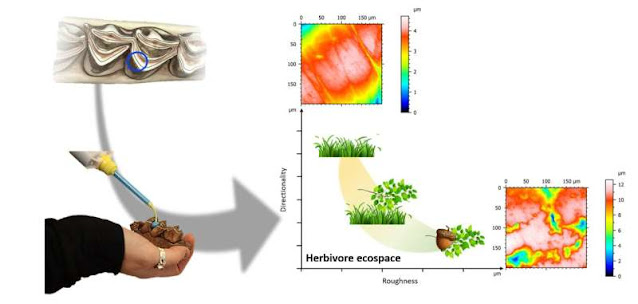From dental facets to paleoecological reconstructions.
Credit: Emilie Berlioz, CC-BY 4.0 (creativecommons.org/licenses/by/4.0/)
The archaeological site of Combe-Grenal in France was inhabited by Neanderthals for many millennia throughout the Middle Paleolithic from around 150,000 to 45,000 years ago. These inhabitants hunted local animals whose remains are also found at the site.
During the Neanderthals' occupation, the region experienced numerous oscillations of climate and environmental conditions which are known to have impacted the habits of local fauna. In this study, Berlioz and colleagues investigated the habitat preferences of species hunted by the Neanderthals to investigate whether these environmental shifts affected Neanderthal hunting strategies.
The authors examined nearly 400 specimens of hunted animals from the site, including bison, aurochs, red deer, and reindeer, using wear on the animals' teeth to infer their diets during the final days of their lives. The animals were found to have fed predominantly on plants growing in an open, tundra-like environment.
This pattern was consistent across the many millennia recorded at Combe-Grenal, suggesting that these hunted animals continued to prefer an open-habitat feeding ecology, even during times of significant climate fluctuations. As a result, Neanderthal hunters "stayed in the open," and were not forced to switch to hunting tactics adapted to close encounters in forested environments.
In Combe-Grenal, these results put into perspective the link generally established between the evolution of the production of lithic tools and the adaptation of hunting strategies of human populations in response to environmental changes.
Dental molds for dental microwear analysis, aiming at deciphering the paleoenvironments exploited by Neanderthal populations.
Credit: Aurora Diaz Obregon, CC-BY 4.0 (creativecommons.org/licenses/by/4.0/)
This information is essential to understanding the influences of local environmental changes on material culture or the human history. Further examination of similar data at other sites will allow researchers to investigate whether this trend holds true at different times and in different regions.
The authors add that "Dental microwear texture analysis of ungulate preys at Combe-Grenal shows Neanderthal hunting strategies were unaffected by climatic and environmental oscillations throughout millennia."
Recommend this post and follow
The birth of modern Man



No comments:
Post a Comment
Stick to the subject, NO religion, or Party politics